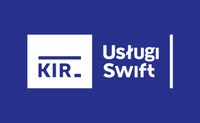



KIR as the SWIFT Service Office
KIR, using the status of the SWIFT Service Bureau, is the only company in Poland that provides banks with access to SWIFTNet - global telecommunications network, which allows to send messages to and from SWIFTNet, using the ICT infrastructure of KIR. Access to SWIFTNet via KIR can also be used as a back-up link. KIR, as the SWIFT Service Bureau, also offers conversion services, which can be used when the back-office application of the bank does not support the SWIFT MT/MX formats or supports them only partially. They allow transformation between proprietary and SWIFT formats (MT, MX), extending the content of messages and data mapping.

KIR, as the SWIFT Service Bureau, offers a common system ground in the form of SWIFT Alliance Access, SWIFT Alliance WebPlatform, SWIFT Alliance Gateway and the converter (IPLA).
Methods of connecting to the SWIFT Service Bureau:
- Leased line between a bank and a SWIFT Service Bureau.
- Encrypted "Gateway to Gateway" Internet connection.
SWIFT Service Bureau infrastructure at KIR
![SWIFT_Infrastruktura ServiceBureau w KIR.png [123.05 KB]](https://www.kir.pl/storage/image/core_files/2023/1/11/75fc6b2291ba6235a42992b81a97697c/png/kir/preview/SWIFT_Infrastruktura%20ServiceBureau%20w%20KIR.png)
Correspondent Banking
The service enables the bank to exchange transactions in any currency with more than 11 thousand SWIFTNet users worldwide. Messages are sent to/from SWIFTNet from/to any location via telecommunication and application infrastructure of the SWIFT Service Bureau owned by KIR.
Access to SORBNET2
KIR, as the SWIFT Service Bureau, provides the bank with access to SWIFTNet and enables the exchange of payment orders and informational messages with the SORBNET2 clearing system.
Depending on the bank application, the SORBNET2 system can be accessed in two modes:
- Application–to–Application (A2A) – when the bank application enables automated sending and receiving of MT and MX messages on the SWIFTNet,
- User–to–Application (U2A)– when MT messages are handled directly from the workstation on which the WebPlatform user is defined.
Within the SWIFTNet the following services and types of messages are used:
- exchange of payment orders and informational messages – MT messages, FIN and FIN Copy service,
- monitoring and management of the account in A2A mode – XML messages, InterAct, FileAct services.
Both modes can be used simultaneously.
Access to SORBNET2
The service enables the bank, as a direct participant in the TARGET2 system, access to the integrated technical Single Shared Platform of the TARGET2 system.
As part of the service, the following SWIFT communication services are made available:
- SWIFTNet FIN and FIN Copy– used for transmission of payment and settlement messages,
- SWIFTNet FileAct– used for distribution and updating of the TARGET2 directory and transmission of reports,
- SWIFTNet InterAct– allows to exchange messages between the participant and the TARGET2 system in real time to monitor credit risk, manage liquidity and provide security,
- SWIFT WebAccess – enables secure, web-based access to the TARGET2 service and provides access to the ICM module via a web browser. Allows participants to verify information on current liquidity, monitor the payment queue and the system status.
Access to business services
KIR, as the SWIFT Service Bureau, provides the bank with access to many financial services in SWIFTNet, one of them is SWIFTNet Cash Reporting.
SWIFTNet Cash Reporting – the service has been established in response to the need to exchange real-time information about cash balances on accounts with different institutions. SWIFTNet Cash Reporting allows:
- Service Providers:
- to gain a competitive advantage by offering advanced services to their clients,
- to increase the level of client satisfaction by timely provision of information to the owners of accounts,
- to streamline clearing risk management by real-time access to information about balances on various accounts. - Service Users:
- to better monitor cash positions,
- to make more accurate calculations of global involvement and obtain greater transparency of clearing risk,
- to improve error detection and streamline error handling processes,
- to improve operational efficiency and shorten complaint handling processes,
- to increase the level of STP (Straight Through Processing) and introduce full automation of the payment transaction cycle.
What are the benefits of SWIFTNet Cash Reporting in different areas of cash management?
- Liquidity management– access to reliable and accurate information about the status of the transaction and the balances on the accounts before closing of the clearing systems allows to streamline the liquidity management.
- Risk management– access to information on the nostro accounts in real time allows the banks to monitor, on an ongoing basis, their actual exposure towards other financial institutions or clients. As a result, the clearing risk and credit risk are significantly reduced.
- Exception handling– earlier detection of non-compliance (e.g. blocked or queued transactions) greatly facilitates and shortens the process of its removal. With the decreasing number of queries received the bank's costs are optimized and customer satisfaction is increased.
- Extending the offer for customers– users may use information about the nostro account in real time in order to accelerate the provision of services to their own corporate clients or other financial institutions.
- Process improvement– information on nostro accounts in real time enables the banks to conduct internal structural changes relevant to back-office processes, which lead to significant cost savings.
Transaction Screening - service provides messages’ screening against up-to-date and comprehensive sanctions lists in real-time. Service enables a range of logical tests (to detect misspellings, abbreviations and phonetic similarities) and sensitivity thresholds and maintain 30 sanctions lists from all the major regulatory bodies. The screening engine is hosted, managed and maintained by SWIFT. Bank can choose real-time screening of all structured message formats (FIN, ISO 20022, SEPA and non-SWIFT formats) or just incoming and outgoing FIN messages.
To ensure bank can handle flagged messages in line with its overall compliance and operational processes, the filter can be set to block all suspicious transactions for investigation, or to alert bank to matches without blocking delivery. There’s also a choice of standard or “4-eyes” workflow options. Bank can select the sanctions lists it wants applied, and add its own lists. Service has also built in automatic monthly reporting along with the needed audit requirements like a trail of all configuration choices, actions and decisions; screening parameters; most relevant matches; and sanctions lists content.
Back-up access
KIR may act as an intermediary in the electronic transmission of messages from the bank's seat to SWIFTNet in case of failure of access infrastructure used to exchange financial information with clearing systems (SORBNET2, TARGET2, Elixir, Euro Elixir) and within the so-called correspondent banking.
KIR provides the SWIFT Service Bureau infrastructure that allows to use all the data transfer mechanisms in SWIFTNet, such as FIN, FileAct, InterAct and WebAccess.
Transmission of messages
Sending messages to SORBNET2/TARGET2 and correspondent banking systems
The messages created in the bank are sent to the SWIFT Service Bureau through:
- dedicated link operating within Extranet,
- "Gateway to Gateway" Internet connection, encrypted based on CISCO router and IPSEC protocol. The connection and its bandwidth are selected by the bank, which also bears all costs related to its use.
![SWIFT_przesyłanie komunikatów do systemu SORBNET_TARGET.png [21.84 KB]](https://www.kir.pl/storage/image/core_files/2023/1/11/571fd5d43691808332c25718a21e3065/png/kir/preview/SWIFT_przesyłanie%20komunikatów%20do%20systemu%20SORBNET_TARGET.png)
KIR provides its clients with the SWIFT Alliance Access interface, so that the client's messages loaded from the business systems are automatically sent to SWIFTNet. The SAA application is equipped with Automated File Transfer allowing to exchange files with messages between the client's business applications and SAA.
The client's business system places files to be sent in appropriate directory on the SFTP server, and then, in accordance with the established rules of routing of messages in SWIFTNet, the messages are automatically sent to SWIFT. In the routing rules, in addition to sending messages to SWIFTNet, you can also specify the method of printing of all or a specified group of messages on a printer at the client's premises. Copies of the messages in the text version can also be saved in the so-called Archive for later use.
Similarly, incoming files from SWIFTNet are, in an automated method defined by routing rules, stored in an appropriate directory on the SFTP server with the option to be automatically printed or sent to the business system.
Transmission of transactions
Transmission of transactions to the Elixir / Euro Elixir system:
- KIR allows the bank to transfer transactions addressed to the Elixir / Euro Elixir system using SWIFTNet.
- Transactions are sent to/from the Elixir / Euro Elixir system via the bank's SWIFT infrastructure and SWIFTNet in the form of files using FileAct communication protocol.
![SWIFT_przesyłanie transakcji do systemu Elixir_Euro Elixir.png [16.34 KB]](https://www.kir.pl/storage/image/core_files/2023/1/11/6114c8bf204a04fc42e4df10d29ce6f6/png/kir/preview/SWIFT_przesyłanie%20transakcji%20do%20systemu%20Elixir_Euro%20Elixir.png)
Conversion services
Conversion services offered by KIR are applicable when the back-office application of the client does not support the SWIFT MT/MX formats or supports them only partially. They enable automation of handling of transactions sent from/to the back-office applications to/from SWIFTNet by providing an integration platform under the SWIFT Service Bureau infrastructure.
As part of the offered integration services KIR allows to:
- transform data between proprietary and SWIFT formats (MT, MX),
- aggregate and disaggregate messages,
- control duplicate messages,
- validate transactional data in accordance with the criteria set by the client/SWIFT rules,
- map data,
- expand the content of messages,
- copy data to directories for external processing,
- encrypt transmitted data,
- monitor the status of the sent and received business data from business application to/from SWIFT,
- configure and manage connections to one or more business applications using the files.
The conversion services allow automation of handling of any transactions transmitted between the back-office application and other systems (correspondent banking/SORBNET2/TARGET2) by using of an integration module (IPLA) provided under the SWIFT Service Bureau infrastructure of KIR.


